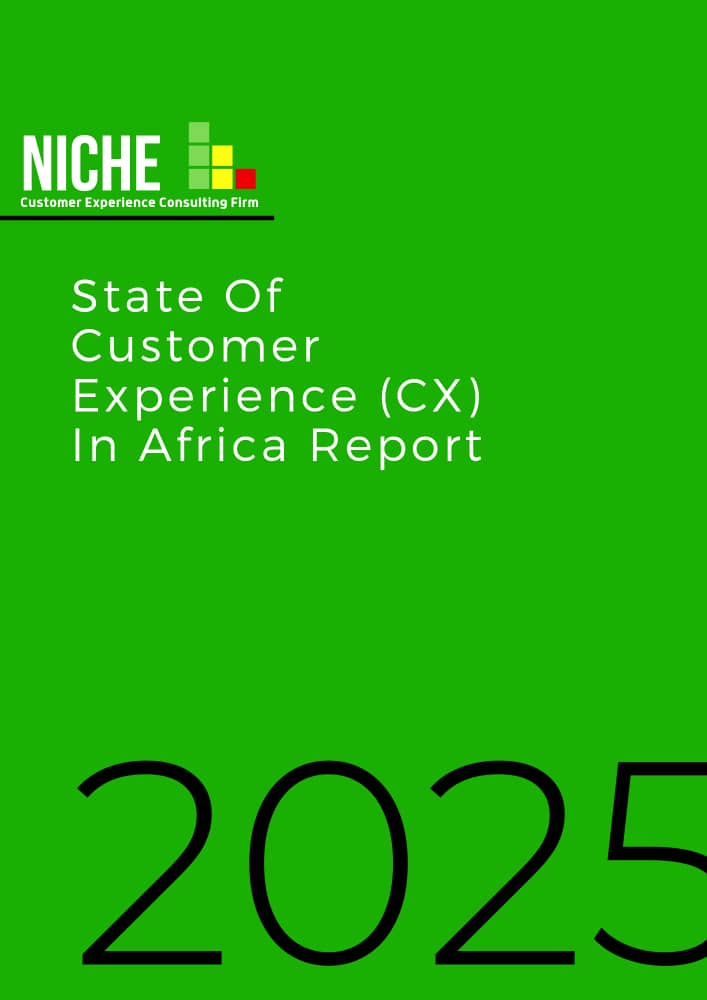The banking sector in Nigeria has evolved commendably over the years from a focus on demand deposit accounts (DDA) to a focus on DDA and the customer. Thanks to KPMG Nigeria, since 2007, the banking sector has had access to an independent evaluation of customer satisfaction. This has made banks more attentive to the voice of customers.
The report has consistently provided deep insights on customer behaviour in the banking sector and has over time evolved into a focus on customer cycle stages in line with a banking customer’s overall experience.
My Research

I carried out some research while visiting 3 banks in Nigeria that have consistently featured in the industry satisfaction survey report.
Specifically, I was looking to open a company account in 3 different currencies (NGN, USD & EURO), a personal account in 3 currencies (NGN, USD & EURO) and an account for my daughter.
For each bank I visited, the experience was transactional and lacked personalization and interest in wanting to know me as a customer and why I wanted the accounts. When I mentioned I was interested in opening an account, I was asked the type of account, given an account opening package and the personnel attending to me, moved on to other things. In each occasion, I read through the forms, asked questions and all officers responded to me reluctantly. I was not engaged beyond the basic question; “What type of account do you want to open?”.
My Profile
Before my journey/research, I had specific needs as a customer from a personal and business perspective. In more detail, below is a summary of my profile as a customer (figure 1).

With my needs in mind, I read through the report (2019 and 2020 reports), noted the banks that featured top 3 as ranked by SMEs and retail customers and decided to visit these banks in my search for financial products and services that will meet my need.
My Journey
One would think that with a profile like mine if I was engaged properly i.e. asked the right questions to understand my needs, all 3 banks visited will see 5 relationship opportunities i.e.(figure 2)

Because the approach to customer engagement at the engage stage of my journey was transactional with no focus on my profile and specific needs, all banks failed to see the potential in me as a customer and were satisfied with just giving me a list of account opening requirements.
From an overall customer journey perspective, the below (figure 3) is a pictorial summary of my entire experience.

My journey above got me thinking. With all the feedback and customer insights provided by the annual KPMG Nigeria Banking Industry Customer Satisfaction Survey (BICSS) report and current customer satisfaction levels of these banks, what is wrong with the picture howbeit I am just one customer out of 206 million Nigerians (source:statista.com) and 1 small business owner out of 41.5 small business owners (source: sme360.ng)? What is missing?
From my experience working in the banking sector (10 years), I know how seriously banks take this report but my question is, are they using it for the right reasons? Are they focused on the right insights or are they just focused on being number one but fixing what is on the surface?
My Summation
While the report is an excellent initiative i.e. providing insights into drivers of customer satisfaction, dissatisfaction and loyalty annually, I think that the traditional banks do not reflect an understanding of the initiative in their operations and understanding of customer experience as it bothers on the full scope of customer experience activities in a business i.e.:
- Customer persona definition. From all my interactions with banks, my perception stays the same, customers are just numbers. There is not much that goes into understanding and defining customer personas or profiles for different customer groups
- Financial product and service design. There is mostly an inside-out approach to product/service design.

- Customer relationship management. From my perspective, relationship management is considered a job role and not a process. Because it is not considered a process, there is a lot of reliance on human beings to manage customer relationships and no deliberate attempt to harmonize marketing, sales, customer support and customer loyalty activities to know customers beyond account numbers, account balances or relationship managers.
- Customer data management and mastery. Data is gold but I do not think traditional banks understand that with the quality of customer data at their disposal, they are in a great position to offer customers personalized, enjoyable, valuable and effortless experiences despite mandatory industry regulatory guidelines and requirements
- Customer evolution management. We all need financial products or services. Whether it is a need for financial dependence, financial discipline or financial independence, banks are uniquely positioned to fit into our lifestyle so it is expected that banks manage our evolution as human beings. In my view, little or no attention is paid to changes in customer dynamics largely because customer segmentation focus is primarily value-based and not need-based or inspired by customer behaviour
- Mistaking customer experience for customer service. Customer experience is not customer service. What traditional banks understand as customer experience is customer service and the teams they have set up to manage customer experience are customer service management teams and not customer experience management teams. This understanding has therefore negatively impacted how these teams are set up from recruitment or reassignment of employees to training and resource availability resulting in a reactive approach to managing customer experience.
My Recommendations
For traditional banks in Nigerian to strategically improve customer experience per customer group, per channel and per product/service (which will ultimately reflect in the industry’s annual customer satisfaction report), consider the below.

- STOP chasing customer satisfaction scores and rankings. Chase the customer. The customer should be the focus of your customer satisfaction enhancement initiatives. This means that while noting the drivers of dissatisfaction, deep dive into the why, the who, the what, the where, the when and the how. Try not to set and chase unrealistic rankings over a short period which impedes an organic improvement in CX maturity
- EXPAND (A) knowledge of customer experience. Customer experience (the sum of all interactions a customer has with a bank, end to end) is not the same thing as customer service (professional assistance offered to a customer). Knowing the difference is important. It is compulsory for traditional banks to take the time and put in the work to convert products, services, channels, brand identity, brand promises and brand values into a customer journey blueprint. Defining the cycle stages and articulating how customers should feel after every interaction at each cycle stage is a recipe for success because it leads to effective customer management that will impact industry customer satisfaction ranking and customer profitability.
- EXPAND (B) knowledge of how to manage customer’s experience. Expanding knowledge of customer experience requires expanding the knowledge of how to manage customer experience. From my experience working in the banking sector for 10 years, the banking industry in Nigeria is one industry where silos thrive and expanding how you manage customer experience across all job roles is a great way to break the silos keeping everyone focused on the bigger picture which is delivering on a customer journey blueprint.

- EMBRACE (A) customer relationship management (CRM) as a process. CRM is typically associated with a software or tool but the truth is, it is first a process and tools/software have been created to support the execution of the process. CRM is a business process via which businesses acquire, satisfy and retain customers, therefore, it is more than a job role but a process that cuts across marketing, sales, customer support, customer loyalty roles and systems. Imagine a bank with 18 million customers (UBA Plc – source:ubagroup.com), 12 million customers (First Bank – source: firstbanknigeria.com), 8 million customers (GTbank – source: relbank.com) and 1.2 million customers (Zenith Bank – source: zenithbank.com)? Focusing on the frontline and relationship managers without a centralized CRM process is a recipe for disaster.
- EMBRACE (B) technology. With the above statistics on traditional banks in view, banks in Nigeria should prioritize a CRM technology solution to proactively acquire, satisfy and retain customers. It is one thing to design an onboarding or customer engagement process, its another thing to design one to be implemented by humans and its a greater thing to design one that runs independently of humans beings to some degree. Sending only a text message to a customer after an account has been open (with the account number) is not enough for an onboarding experience which has an adverse effect on a bank’s ability to get to know customers deeply and personalize its approach to cross-selling and upselling which in turn increases a bank’s customer profitability

- EMBRACE (C) digitalization. Several transactions still require face-to-face interactions. While they may be restrictions from a regulatory standpoint, traditional banks should consider reviewing customer-impacting business processes to save customers time, effort and money
In Summary
There is work to be done and traditional banks in Nigeria have not even scratched the surface of customer experience or customer experience management. While it is great to affiliate with, catch up with or emulate global trends by adopting the use of chatbots and other artificially intelligent solutions, if the right customer relationship management foundation is not laid leading to proactive customer experience management, then banks in Nigeria are simply chasing scores and what will happen over time is that improved ratings or rankings will not be sustainable.
A smart way to leverage the insights provided by the industry customer satisfaction report will be to review the report, deep dive into the bank-specific current state of customer experience end to end (in line with customer journey) and gauge current customer experience maturity level so that root causes are identified and fixed at source in customer journey. This way, its easier and more strategic to track return on improvement investment (without waiting for the next industry report) and set short term and long term customer experience improvement goals irrespective of the industry report. In my view, this will help traditional banks define their customer experience identity, tell their stories, learn their lessons and evolve with customers across all stages of their journey.
Be a master at managing your customer’s experience and let the industry report reflect how amazing you are.

deBBie akwara
Customer Experience Entrepreneur (CXPreneur), Founder & Principal Consultant at Niche Customer Experience Consulting Firm, Author, CX Conference Speaker, CX Thought Leader & Influencer and Co-Founder, Customer Experience Professionals West Africa (CXPWA) Network.



